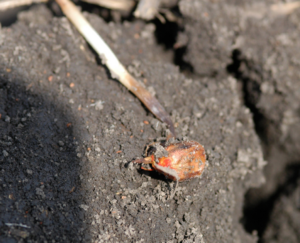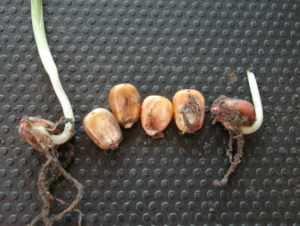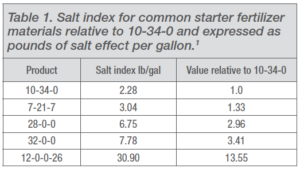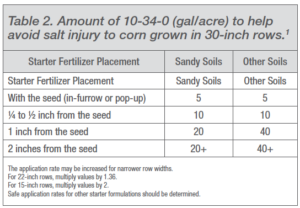- Dry soil moisture conditions can lead to in-furrow or pop-up starter fertilizer damage to corn, especially in lighter textured or sandy soil that is low in organic matter content.
- The amount of in-furrow or pop-up starter fertilizer that can be safely applied is limited, and the type of fertilizer used is important to minimize any potential injury.
Starter Fertilizer and Placement
A starter fertilizer usually is composed of two or more nutrients. A common combination is nitrogen (N) and phosphorus (P). The addition of zinc (Zn) and sulfur (S) may be desirable for some soil conditions. Zinc should be included when the Zn level in the soil is marginally adequate. Sulfur should be added for sandy soils low in organic matter.(1)
Starter fertilizer is defined as the placement of small amounts of nutrients in a concentrated zone close to the seed at planting. Application can be as a band 2 inches to the side and 2 inches below the seed at planting, which is considered the standard application. Additionally, this application method is considered the safest regarding seed or seedling injury by the fertilizer.(1)
However, many planters have in-furrow application equipment used to apply insecticides, fungicides, and fertilizer. In-furrow or pop-up placement of starter fertilizer places it in direct contact with the seed, providing a greater risk of fertilizer injury to the seed, especially in dry soil moisture conditions.
Potential Pop-Up Starter Fertilizer Injury
Pop-up fertilizer is applied in-furrow with the seed, which makes nutrients like N and P more accessible to the plant. If fertilizer use rates are too high or planting time conditions too dry, salt injury can affect the germination of the seed and hamper early growth of seedling corn plants. When injury occurs, stands are reduced as plants are killed or injured and become unable to compete with adjacent corn plants.
Corn seedlings suffering from starter fertilizer injury often lack roots or have roots that look like they have been burned off (Figure 1). If you dig up the plants, the radicle, or the first emerging root, will typically be short and the tip will be brown or black. The radicle can be killed in severe cases of damage. Seedlings from affected seeds that germinate are often stunted or may have a wilted or spindly appearance. Fields exhibiting damage can have uneven emergence with injured plants scattered throughout the field in no specific pattern. Changes in soil texture or moisture levels in the field can be the reason for this scattering of injured plants. Damaged plants may recover by growing new roots, but they can be set back enough to cause a reduction in yield potential.

Figure 1. Starter fertilizer injury to radicle.
Fertilizer Salt, Toxicity, and Rate Effects
A starter fertilizer is generally used to supply N and possibly P. Other nutrients that may be included are potassium (K), S, and Zn. Injury from N, K, and S is possible when corn seed is in direct or very close proximity to these elements.
Micronutrients like Zn can be safely applied; however, Boron (B) can potentially cause damage when applied in a pop-up starter fertilizer. The amount of these elements applied through an in-furrow system requires monitoring, since the seed and fertilizer are being placed in the same furrow. Fertilizers contain salts that disassociate into ionic forms in water. When the salt concentration is high near the seed, there is greater potential to draw water out of the roots, which can result in plant desiccation. Under moist soil conditions, salts can diffuse away from the seed in the soil solution. Under dry soil conditions, minimal diffusion occurs, and fertilizer salts can remain near the seed longer to potentially produce injury (Figure 2).

Figure 2. Starter fertilizer injury to seed and radicle
Plant cells that lose water to surrounding soil that is dry and high in salts will shrink and can eventually die. Fertilizers vary in their salt effects, with some having greater effects than others. Pop-up starter fertilizers should be made from lower salt index forms.
Salt index is a function of the sum of the N, K, and S amounts present in the fertilizer (Table 1). While there are many formulations used as starter fertilizers, liquid 10-34-0 (N-P-K) and 7-21-7 are very common. Ammonium polyphosphate solutions (10-34-0) contain N in the ammonium (NH4) form. Ammonium is one of the forms of N that plants take up and utilize. Urea fertilizer solutions (28-0-0 and 32-0-0) contain N in the ammonia (NH3) form, which can be released under certain soil conditions (high pH, dry soils, low organic matter). Ammonia is a toxic gas that can kill plant cells if it is in high enough concentrations. Ammonium thiosulfate (12-0-0-26) is used in starter fertilizer to supply S to corn and has a high salt index.
Fertilizers containing urea and the thiosulfate ion can pose the greatest injury risk to corn seedlings with in-furrow or pop-up placement. However, high rates of 10-34-0 can also present an injury risk with in-furrow placement in dry years. The rate of starter fertilizer that can be applied safely depends on the fertilizer’s salt index value, the distance between the fertilizer and the seed, and the soil texture.1 Generally, for corn in 30-inch rows, no more than 5 gallons per acre of 10-34-0 should be applied in-furrow with the seed (Table 2). The greatest risk for in-furrow fertilizer damage can occur in sandy or light textured soil
(low in organic matter or clay content) and when soil conditions are dry.(2)

Pop-Up Starter Fertilizer Use Considerations
Starter fertilizer damage to corn with in-furrow or pop-up placement will not occur in all years. When soil moisture at planting is adequate and rainfall occurs soon after planting, problems associated with fertilizer salt damage will be minimal or will not occur. Problems can be anticipated when soil moisture becomes limited, and no rainfall occurs for several weeks after planting. A good quality fertilizer is important with in-furrow or pop-up placement. Recommended rates are generally 4 to 5 gallons per acre for in-furrow applications. A fertilizer with a high P ratio (1-2-1,1-3-1, etc.) in a highly water-soluble form, and combined with ammonium nitrogen can be used. Formulations may change based on availability and if other nutrients are added. Producers should be very cautious applying starter fertilizer that includes N, K, and/or S, or some micronutrients such as B, in direct contact with the seed. Urea nitrogen and thiosulfate forms of fertilizer should be avoided with in-furrow placement to limit potential salt and ammonia injury. Monoammonium phosphate-based materials are good choices, and ammonium polyphosphate (10-34-0) is also an excellent liquid starter. Application equipment must also be functioning properly to deliver uniform low rates of starter fertilizer when using in-furrow or pop-up placement.

Fertilizer injury often occurs from problems with application equipment on the planter. Common problems are getting fertilizer application rates too high, improper settings, lack of or improper calibration, and poor distribution on liquid systems (some rows receiving more than others) that can lead to over-application and fertilizer salt injury. It is important to remember that no fertilizer application is without risk, and there is no fertilizer material that is completely safe for in-furrow or pop-up placement. Understanding the variables involved can help to minimize the risks associated with in-furrow or pop-up placement of starter fertilizer in corn.
